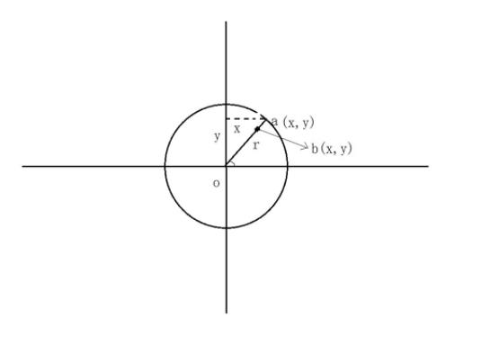今天小编给大家分享一下C++怎么使用easyx画实时走动的钟表的相关知识点,内容详细,逻辑清晰,相信大部分人都还太了解这方面的知识,所以分享这篇文章给大家参考一下,希望大家阅读完这篇文章后有所收获,下面我们一起来了解一下吧。
这次的任务是用c++画出实时走动的钟表,并且与当前系统的时间一致。
由于我们使用的是c++语言,我们更需要用这个例子来提高我们对面向对象程序设计的理解。
我们首先需要分析出需求,“画一个能够实时走动的钟表”,根据需求我们可以好处两个对象,钟表对象与画图对象,所以我们大致先建立两个类,Clock类与Paint类。
Clock类中的成员变量都有:表的中心坐标x与y、表的时间(时、分、秒)、表的大小r(即半径)、表盘的颜色color。
Clock类中无其他函数,只有用于初始化的构造函数。
Paint类中无任何成员变量,只有三个函数:画表盘函数drawClock_bk、画表盘刻度函数drawClock_scale、画表针函数drawClock_sharp
其中画表盘是非常简单的,最最困难的就是画刻度函数与画表针函数。
要想要画出刻度与表针,就必须知道如何得画刻度的两个坐标。
下面先来了解下如何求得坐标(纯数学知识)
如图:

如果要求圆上一点a的坐标(x,y),利用三角函数,若a点与圆心o(x0,y0)连线与x轴的夹角大小为c,r为半径,则a的横坐标x值为x0+cos(c)*r,a的纵坐标y为y0-sin(c)*r,这样就可求得圆上任意一点的坐标。然后我们需要画出刻度,即我们还需要圆心o与圆上一点a的连线上的另一个坐标,这样才可以画出刻度。如图:

如图点b是点a与圆心o连线上的一点。假设我们需要画的刻度长度是s,所以a与b连线的距离为s,b与圆心连线的距离为r-s,所以根据三角函数也可以求得点b的坐标为x:x0+cos(c)*(r-s),y为:y0-sin(c)*(r-s)。
这下有a、b这两点的坐标就可以画出一个刻度了,然后根据表盘的实际分布可以将所有的刻度画出来了(即每个刻度为5度)。
表针的画法与刻度类似:需要找这个b这种点(圆心与圆上的点连线上的点),然后根据你指定的针长和夹角,就可以求出b点的坐标。然后用b点坐标和圆心坐标就可以画出对应的指针了。
最重要的坐标求法就是这样了,剩下具体的细节请看下面代码:
#include <iostream>#include <cstdio>#include <iomanip>#include <graphics.h>#include <conio.h>#include <time.h>#include <cstdlib>#include <cmath> #define PI 3.1415using namespace std; class Clock{public: int _x; int _y; int _hour; int _minute; int _second; int _r; COLORREF _bk_col;public: Clock(int x,int y,int h,int m,int s,int r,COLORREF bk_color) { this->_x = x; this->_y = y; this->_hour = h; this->_minute = m; this->_second = s; this->_r = r; this->_bk_col = bk_color; }}; class Paint{public : void drawclock_bk(Clock c); void drawclock_scale(Clock c); void drawclock_sharp(Clock c);}; void Paint::drawclock_bk(Clock c){ setcolor(RGB(0,0,0)); setfillcolor(RGB(0,0,0)); fillcircle(c._x,c._y,c._r);} void Paint::drawclock_scale(Clock c){ int x1,y1; int x2, y2; setlinecolor(RGB(255, 255, 255)); for (int a = 1; a <= 60;a++) { if (a <= 15) { x1 = static_cast<int>(c._x + (cos(a*(PI / 30)))*c._r); y1= static_cast<int>(c._y - (sin(a*(PI / 30)))*c._r); if (a % 5 == 0) { x2 = static_cast<int>(c._x + (cos(a*(PI / 30)))*(c._r - 15)); y2 = static_cast<int>(c._y - (sin(a*(PI / 30)))*(c._r - 15)); } else { x2 = static_cast<int>(c._x + (cos(a*(PI / 30)))*(c._r - 5)); y2 = static_cast<int>(c._y - (sin(a*(PI / 30)))*(c._r - 5)); } } else if (a > 15 && a <= 30) { x1 = static_cast<int>(c._x + (cos(a*(PI / 30)))*c._r); y1 = static_cast<int>(c._y - (sin(a*(PI / 30)))*c._r); if (a % 5 == 0) { x2 = static_cast<int>(c._x + (cos(a*(PI / 30)))*(c._r - 15)); y2 = static_cast<int>(c._y - (sin(a*(PI / 30)))*(c._r - 15)); } else { x2 = static_cast<int>(c._x + (cos(a*(PI / 30)))*(c._r - 5)); y2 = static_cast<int>(c._y - (sin(a*(PI / 30)))*(c._r - 5)); } } else if (a > 30 && a <= 45) { x1 = static_cast<int>(c._x + (cos(a*(PI / 30)))*c._r); y1 = static_cast<int>(c._y - (sin(a*(PI / 30)))*c._r); if (a % 5 == 0) { x2 = static_cast<int>(c._x + (cos(a*(PI / 30)))*(c._r - 15)); y2 = static_cast<int>(c._y - (sin(a*(PI / 30)))*(c._r - 15)); } else { x2 = static_cast<int>(c._x + (cos(a*(PI / 30)))*(c._r - 5)); y2 = static_cast<int>(c._y - (sin(a*(PI / 30)))*(c._r - 5)); } } else if (a > 45 && a <= 60) { x1 = static_cast<int>(c._x + (cos(a*(PI / 30)))*c._r); y1 = static_cast<int>(c._y - (sin(a*(PI / 30)))*c._r); if (a % 5 == 0) { x2 = static_cast<int>(c._x + (cos(a*(PI / 30)))*(c._r - 15)); y2 = static_cast<int>(c._y - (sin(a*(PI / 30)))*(c._r - 15)); } else { x2 = static_cast<int>(c._x + (cos(a*(PI / 30)))*(c._r - 5)); y2 = static_cast<int>(c._y - (sin(a*(PI / 30)))*(c._r - 5)); } } line(x1, y1,x2, y2); } setfillcolor(RGB(255,255,255)); fillcircle(c._x,c._y,5);} void Paint::drawclock_sharp(Clock c){ int x1, y1; int x2, y2; int x3, y3; setlinecolor(RGB(255,255,255)); x3 = static_cast<int>(c._x + (cos(static_cast<double>(15 - c._second)*(PI / 30)))*static_cast<double>(0.8*c._r)); x2 = static_cast<int>(c._x + (cos(static_cast<double>(15 - c._minute - static_cast<double>(c._second) / 60)*(PI / 30)))*static_cast<double>(0.6*c._r)); x1 = static_cast<int>(c._x + (cos(static_cast<double>(3 - c._hour - static_cast<double>(c._minute) / 60)*(PI / 6)))*static_cast<double>(0.4*c._r)); y3 = static_cast<int>(c._y - (sin(static_cast<double>(15 - c._second)*(PI / 30)))*static_cast<double>(0.8*c._r)); y2 = static_cast<int>(c._y - (sin(static_cast<double>(15 - c._minute - static_cast<double>(c._second) / 60)*(PI / 30)))*static_cast<double>(0.6*c._r)); y1 = static_cast<int>(c._y - (sin(static_cast<double>(3 - c._hour - static_cast<double>(c._minute) / 60)*(PI / 6)))*static_cast<double>(0.4*c._r)); line(c._x, c._y, x1, y1); line(c._x, c._y, x2, y2); line(c._x, c._y, x3, y3);} int main(){ initgraph(1024,576); setbkcolor(RGB(255, 255, 255)); cleardevice(); time_t nowtime; struct tm* ptime; if (time(&nowtime)) { ptime = localtime(&nowtime); } Clock c(512, 288,ptime->tm_hour, ptime->tm_min, ptime->tm_sec, 120, RGB(255, 255, 255)); Paint p1; p1.drawclock_bk(c); p1.drawclock_scale(c); p1.drawclock_sharp(c); int flag=0; while (true) { Sleep(1000); ++c._second; c._second%=60; if (c._second== 0) { c._minute++; } c._minute %= 60; if(c._minute==1) { flag=0; if (c._minute == 0&&flag==0) { c._hour++; flag=1; } c._hour %= 24; p1.drawclock_bk(c); p1.drawclock_scale(c); p1.drawclock_sharp(c); } _getch(); closegraph(); return 0; }vs2013运行效果如图:

以上就是“C++怎么使用easyx画实时走动的钟表”这篇文章的所有内容,感谢各位的阅读!相信大家阅读完这篇文章都有很大的收获,小编每天都会为大家更新不同的知识,如果还想学习更多的知识,请关注编程网行业资讯频道。




